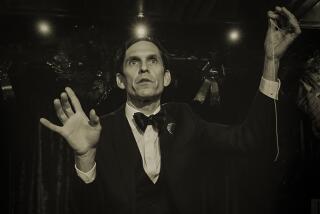With a bang
- Share via
For Cai Guo-Qiang, every time feels like the first time. His nerves still tingle, his mind still races -- during that climactic, split-second moment before he lights the fuse and the gunpowder goes boom.
It’s an intensity that time hasn’t dimmed, not even after 30 years. That’s how long Cai’s been making art with explosions.
“The anxiety is part of my motivation to make artwork,” Cai says. “It’s the allure that draws me back time and again.”
Not to mention the high demand. Cai’s art is known worldwide -- from his native China, where he directed the visual and special effects for the opening and closing ceremonies of the 2008 Summer Olympics in Beijing; to Japan, where he moved as a young artist and stayed for eight years; to New York, where he’s lived ever since. This week marks his West Coast debut, at the Geffen Contemporary at MOCA, where L.A. audiences will get to see his singular brand of gunpowder artwork, otherworldly installations and performance pieces for the first time.
And, in some ways, it will be Cai’s first time too -- just as it always is for this constantly youth-reliving artist. Because, when Cai strikes that match, he reverts, if only for an instant, to his childhood self, to that innocent moment when he first started playing with rockets.
It helped that his hometown, Quanzhou City, was known for its collection of fireworks vendors. Cai had access to all kinds. But that didn’t mean he immediately grasped their artistic potential.
First, he tried firing them headlong into blank canvases, which “wasn’t very successful because the whole canvas would burn completely through,” says Cai, laughing with his Chinese interpreter.
But art was in his DNA. His father was a small-time poet and brush-and-ink calligrapher; and his mother, though not an artist herself, was a superstitious, temple-going, incense-burning woman whose spirituality influenced her son. Soon, Cai found that he could remove the gunpowder from the rockets and ignite it directly on the canvas, creating mystical, chaotic, black-and-brown representations of space, nature and time.
The explosive aspect of the work took on a symbolic meaning for Cai.
“As a person, it’s fine to be careful and cautious, but as a contemporary artist, you may need to break free and let yourself go a little,” he says. “By using gunpowder, I’m trying to destroy my own persona -- almost a rebellion against the slightly oppressive social climate in China at the time.”
In his 20s, Cai moved to Japan, where he fine-tuned his gunpowder technique and made a name for himself as a contemporary artist with a penchant for cosmic meditations. But fearing he wouldn’t be known outside Asia, he left for New York on an art grant and never went back.
Cai, 54, still works constantly from his New York studio. In 2008, the Guggenheim Museum hosted a retrospective of his work, which at the time became the best-attended exhibition in the museum’s history.
Jeffrey Deitch, MOCA’s director and the curator of the current exhibition, called “Sky Ladder,” has known Cai for some 20 years, having first seen his work in Japan in the early ‘90s, and considers him “one of the major artists in the world today.”
“I’m always attracted to artists who reinvent how to be an artist,” Deitch says. “He’s not someone who introduced a minor new variation on painting or a new take on a given genre. He has really invented a fresh new form.”
At MOCA, Cai is showcasing three gunpowder drawings, made in Los Angeles with help from local volunteers, and one crop circle installation. On Sunday afternoon he’ll be sitting down with Deitch for a talk about his work.
But what’s most anticipated is Saturday’s signature “explosion event” -- a multi-part, one-off kaboom-fest called “Mystery Circle.” Some 40,000 fireworks rockets will shoot out of the Geffen’s north wall at 7:30 p.m. toward the audience in crop circle-like formation, followed by the release of pyrotechnic UFOs and the illumination of an alien-god figure whose headpiece will ignite in flames. Think of it as “a mural that expands in space,” Cai says.
But there’s still the uncertainty of that moment, the question of whether everything will go as planned -- the anxiety that drives Cai and his art.
“At the moment of ignition, there’s a very dramatic transformation happening,” he says. “It almost ties the audience’s destiny with the artist and the artwork. They’re all waiting to see what will happen in the end.”
--
More to Read
The biggest entertainment stories
Get our big stories about Hollywood, film, television, music, arts, culture and more right in your inbox as soon as they publish.
You may occasionally receive promotional content from the Los Angeles Times.










